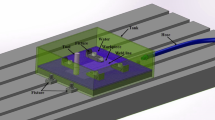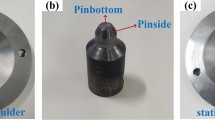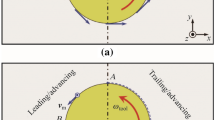Abstract
The coupled Eulerian-Lagrangian (CEL) method was used to simulate underwater friction stir welding with rotational shoulder (RFSW) and stationary shoulder (SSFSW) tools. New equations for time-dependent pressure distribution and heat transfer coefficients and temperature-dependent friction coefficient were used. In simulation results, the SZ width had the maximum error of 2.5 % compared to experimental measurement. Material flow during SSFSW was divided into two categories: horizontal flow (HF) and backflow (BF). The result of collision of material flows was the formation of an upward material flow that was concentrated in the middle of the thickness. Consequently, an elliptical stir zone was produced in SSFSW. However, the intense material flow of the shoulder in RFSW produced a downward flow orientation. The maximum welding forces along the x, y, and z axes for the SSFSW are about 44, 25, and 31% higher than the RFSW, respectively. The increase in welding forces in SSFSW increased the material flow velocity around the pin and caused a higher intensity in BF and HF. The interfacial force applied to the surrounding material in the low temperature sample was decreased by 55% compared to the moderate temperature sample, and a cavity defect was formed.


















Similar content being viewed by others
Data and code availability
Not applicable
References
Mishra RS, Ma ZY (2005) Friction stir welding and processing. Mater Sci Eng 50:1–78. https://doi.org/10.1016/j.mser.2005.07.001
Al-Badour F, Merah N, Shuaib A, Bazoune A (2013) Coupled Eulerian Lagrangian finite element modeling of friction stir welding processes. J Mater Process Technol 213(8):1433–1439. https://doi.org/10.1016/j.jmatprotec.2013.02.014
Chu Q, Yang XW, Li WY, Vairis A, Wang WB (2018) Numerical analysis of material flow in the probeless friction stir spot welding based on Coupled Eulerian-Lagrangian approach. J Manuf Process 36:181–187. https://doi.org/10.1016/j.jmapro.2018.10.013
Al-Badour F, Merah N, Shuaib A, Bazoune A (2014) Thermo-mechanical finite element model of friction stir welding of dissimilar alloys. Int J Adv Manuf Technol 72(5–8):607–617. https://doi.org/10.1007/s00170-014-5680-3
Zhu Z, Wang M, Zhang H, Zhang X, Yu T, Wu Z (2017) A finite element model to simulate defect formation during friction stir welding. Metals 7:256–271. https://doi.org/10.3390/met7070256
Wen Q, Li WY, Gao YJ, Yang J, Wang FF (2018) Numerical simulation and experimental investigation of band patterns in bobbin tool friction stir welding of aluminum alloy. Int J Adv Manuf Technol. https://doi.org/10.1007/s00170-018-2750-y
Gupta V, Upadhyay P, Fifield LS, Roosendaal T, Sun X, Nelaturu P, Carlson B (2018) Linking process and structure in the friction stir scribe joining of dissimilar materials: a computational approach with experimental support. J Manuf Process 32:615–624. https://doi.org/10.1016/j.jmapro.2018.03.030
Shokri V, Sadeghi A, Sadeghi MH (2018) Thermomechanical modeling of friction stir welding in a Cu-DSS dissimilar joint. J Manuf Process 31:46–55. https://doi.org/10.1016/j.jmapro.2017.11.004
Chauhan P, Jain R, Pal SK, Singh SB (2018) Modeling of defects in friction stir welding using coupled Eulerian and Lagrangian method. J Manuf Process 34:158–166. https://doi.org/10.1016/j.jmapro.2018.05.022
Ahmad B, Galloway A, Toumpis A (2018) Advanced numerical modelling of friction stir welded low alloy steel. J Manuf Process 34:625–636. https://doi.org/10.1016/j.jmapro.2018.07.003
Wen Q, Li WY, Wang WB, Wang FF, Gao YJ, Patel V (2018) Experimental and numerical investigations of bonding interface behavior in stationary shoulder friction stir lap welding. J Mater Sci Technol. https://doi.org/10.1016/j.jmst.2018.09.028
Melaku LE, Tura AD, Mamo HB, Santhosh AJ, Ashok N (2022) Optimization and thermal analysis of friction stir welding on AA6061 aluminum alloys. Mater Today: Proc 65:3348–3356. https://doi.org/10.1016/j.matpr.2022.05.463
Nandan R, Roy GG, DebRoy T (2007) Three-dimensional heat and material flow duringfriction stir welding of mild steel. Acta Mater 55(3):883–95. https://doi.org/10.1016/j.actamat.2006.09.009
Cho HH, Hong ST, Roh JH, Choi HS, Kang SH, Steel RJ, Han HN (2013) Three-dimensionalnumerical and experimental investigation on friction stir welding processes offerritic stainless steel. Acta Mater 61(7):2649–6. https://doi.org/10.1016/j.actamat.2013.01.045
Su H, Wu CS, Pittner A, Rethmeier M (2014) Thermal energy generation and distribution in friction stir welding of aluminum alloys. Energy 77:720–31. https://doi.org/10.1016/j.energy.2014.09.045
Meyghani B (2021) A modified friction model and its application in finite-element analysis of friction stir welding process. J Manuf Process 72:29–47. https://doi.org/10.1016/j.jmapro.2021.10.008
Meyghani B, Awang M, Emamian S, Khalid NM (2017) Developing a finite element model for thermal analysis of friction stir welding by calculating temperature dependent friction coefficient, In: Awang, M. (eds) 2nd International Conference on Mechanical, Manufacturing and Process Plant Engineering. Lecture Notes in Mechanical Engineering. Springer, Singapore. https://doi.org/10.1007/978-981-10-4232-4_9
Zhang XX, Xiao BL, Ma ZY (2011) A transient thermal model for friction stir weld. Part I: Model Metall Mater Trans A 42A:3218. https://doi.org/10.1007/s11661-011-0729-5
Shi L, Wu CS (2017) Transient model of heat transfer and material flow at different stagesof friction stir welding process. J Manuf Process 25:323–339. https://doi.org/10.1016/j.jmapro.2016.11.008
M. Mehta, K. Chatterjee, A. De, (2013), Monitoring torque and traverse force in friction stir welding from input electrical signatures of driving motors. Sci Technol Weld Join 18. https://doi.org/10.1179/1362171812Y.0000000084
Shi L, Wu CS, Liu HJ (2014) Numerical analysis of heat generation and temperature field in reverse dual-rotation friction stir welding. Int J Adv Manuf Technol 74:319–334. https://doi.org/10.1007/s00170-014-5967-4
Mijajlovic M, Milcic D (2012) Analytical model for estimating the amount of heat generated during friction stir welding: application of plates made of aluminum alloy 2024 T351. In: Radovan Kovacevic (ed) Welding processes, Janeza Trdine 9, 51000 Rijeka, Croatia, p 247–274
Hosseini MM, BasiratTabrizi H, Jalili N (2016) Thermal optimization of friction stir welding with simultaneous cooling using inverse approach. Appl Ther Eng 108:751–763. https://doi.org/10.1016/j.applthermaleng.2016.07.143
Nandan R, DebRoy T, Bhadeshia HKDH (2008) Recent advances in friction-stir welding –process, weldment structure and properties. Prog Mater Sci 53:980–1023. https://doi.org/10.1016/j.pmatsci.2008.05.001
Shi L, Wu CS, Padhy GK, Gao S (2016) Numerical simulation of ultrasonic fieldand its acoustoplastic influence on friction stir welding. Mater Design 104:102–15. https://doi.org/10.1016/j.matdes.2016.05.001
Yang H, Li J, Liu G, Wang C, Li M, Jiang H (2019) Numerical analysis of transient wellbore thermal behavior in dynamic deepwater multi-gradient drilling. Energy 179:138–153. https://doi.org/10.1016/j.energy.2019.04.214
Barber JR (2018) Contact mechanics, Springer International Publishing AG, Solid Mechanics and Its Applications 250, ISBN 978-3-319-70938-3, ISBN 978-3-319-70939-0 (eBook). https://doi.org/10.1007/978-3-319-70939-0
Goryacheva I, Sadeghi F (1995) Contact characteristics of a rolling/sliding cylinder and a viscoelastic layer bonded to an elastic substrate. Wear 184:125–132. https://doi.org/10.1016/0043-1648(94)06561-6
Arora A, De A, DebRoy T (2011) Toward optimum friction stir welding tool shoulder diameter. Scr Mater 64(1):9–12. https://doi.org/10.1016/j.scriptamat.2010.08.052
www.kistler.com, Cutting force measurements in research and development, High-precision measurement systems for metal-cutting production, Kistler Group Eulachstrasse 22 8408 Winterthur Switzerland Tel. +41 52 224 11 11. https://www.kistler.com/INT/en/cp/multicomponent-dynamometers-maximum-forces-up-to-60-kn-cover-plate-260x260-mm-9255c/P0000674
Johnson GR, Cook WH (1983) A constitutive model and data for metals subjected tolarge strains high strain rates and high temperatures, Proc. 7th Int. Symp. Ballist, p. 541–7
Yang C, Dai Q, Shi Q, Wu C, Zhang H, Chen G (2022) Flow-coupled thermo-mechanical analysis of frictional behaviors at the tool-workpiece interface during friction stir welding. J Manuf Process 79:394–404. https://doi.org/10.1016/j.jmapro.2022.05.003
Wang X, Gao Y, Liu X, McDonnell M, Feng Z (2021) Tool-workpiece stick-slip conditions and their effects on torque and heat generation rate in the friction stir welding. Acta Materialia 213:116969. https://doi.org/10.1016/j.actamat.2021.116969
Gao EZ, Zhang XX, Liu CZ, Ma ZY (2018) Numerical simulations on material flow behaviors in whole process of friction stir welding. Trans Nonferrous Met Soc China 28:2324–2334. https://doi.org/10.1016/S1003-6326(18)64877-0
Dialami N, Chiumenti M, Cervera M, Segatori A, Osikowicz W (2017) Enhanced friction model for friction stir welding (FSW) analysis: simulation and experimental validation. Int J Mech Sci 133:555–567. https://doi.org/10.1016/j.ijmecsci.2017.09.022
Jain R, Kumari K, Kesharwani, Kumar S, Pal SK, Singh SB, Panda SK, Samantaray AK (2015) friction stir welding: scope and recent development. Modern Manuf Eng Mater Form 179-229. https://doi.org/10.1007/978-3-319-20152-8_6
Li JQ, Liu HJ (2013) Effects of tool rotation speed on microstructures and mechanical properties of AA2219-T6 welded by the external non-rotational shoulder assisted friction stir welding. Mater Design 43:299–306. https://doi.org/10.1016/j.matdes.2012.07.011
Wu H, Chen YC, Strong D, Prangnell P (2015) Stationary shoulder FSW for joining high strength aluminum alloys. J Mater Process Technol 221:187–196. https://doi.org/10.1016/j.jmatprotec.2015.02.015
Ji SD, Meng XC, Li ZW, Ma L, Gao SS (2016) experimental study of stationary shoulder friction stir welded 7N01-T4 aluminum alloy. JMEPEG 25:1228–1236. https://doi.org/10.1007/s11665-016-1954-2
Salhan P, Singh R, Jain P, Butola R (2022) Prediction of heat generation and microstructure of AA7075 friction stir welding using ANN: Effect of process parameters. Manuf Lett 32:5–9. https://doi.org/10.1016/j.mfglet.2022.01.004
Liu Z, Ji S, Meng X, Huang R (2017) Improving joint formation and tensile properties of friction stir welded ultra-thin Al/Mg alloy sheets using a pinless tool assisted by a stationary shoulder. Int J Adv Manuf Technol 93:2071–2079. https://doi.org/10.1007/s00170-017-0682-6
Author information
Authors and Affiliations
Contributions
All authors contributed to the study conception and design. The first draft of the manuscript was written by Akbar Hosseini based on PHD thesis and under supervision of Dr Alireza Fallahi Arezoudar. All authors read and approved the final manuscript.
Corresponding author
Ethics declarations
Ethical approval
Not applicable
Competing interests
The authors declare no competing interests.
Additional information
Publisher's Note
Springer Nature remains neutral with regard to jurisdictional claims in published maps and institutional affiliations.
Appendix. User subroutine VFRIC
Appendix. User subroutine VFRIC


The variables used in the subroutine are introduced in this section for information [from the Abaqus 6.14 documentation: http://130.149.89.49:2080/v6.14/]:
Description | |
|---|---|
statev(nstateVar, nSlvNod) | This array contains the user-defined solution-dependent state variables for all the nodes on the slave surface |
kStep | Step number |
kInc | Increment number |
nContact | Number of contacting slave nodes |
nFacNod | Number of nodes on each master surface facet |
dtimCur | Current increment in time |
timGlb | Value of total time |
timStep | Value of step time |
jConMstid(nFacNod, nContact) | This array lists the surface node numbers of the master surface nodes that make up the facet with which each contact point is in contact |
nMstNod | Number of master surface nodes |
jMstUid(nMstNod) | This array lists the user-defined global node numbers of the nodes on the master surface |
jSlvUid(nSlvNod) | This array lists the user-defined global node numbers of the nodes on the slave surface |
numDefTfv | Equal to nContact if the master surface is made up of facets |
nPred | Number of predefined field variables |
jConSlvid(nContact) | This array lists the surface node numbers of the slave surface nodes that are in contact |
nTemp | 1 if the temperature is defined and 0 if the temperature is not defined |
nSlvNod | Number of slave nodes |
nProps | User-specified number of property values associated with this friction model |
nStateVar | Number of user-defined state variables |
nDir | Number of coordinate directions at the contact points |
nFricDir | Number of tangent directions at the contact points |
surfInt | User-specified surface interaction name, left justified |
shape(nFacNod, nContact) | For each contact point this array contains the shape functions of the nodes of its master surface facet, evaluated at the location of the contact point |
frictionWork | This variable contains the value of the total frictional dissipation in the entire model from the beginning of the analysis |
fNormal(nContact) | This array contains the magnitude of the normal force for the contact points applied at the end of current time increment |
fTangPrev(nDir, nContact) | This array contains the values of the frictional force components calculated in the previous increment but provided in the current local coordinate system [zero for nodes that were not in contact] |
fStickForce(nContact) | This array contains the magnitude of frictional force required to enforce stick conditions at each contact point |
dSlipFric(nDir, nContact) | This array contains the incremental frictional slip during the current time increment for each contact point in the current local coordinate system |
lContType | Contact type flag |
surfMst | Master surface name |
surfSlv | Slave surface name |
tempSlv(nContact) | Current temperature at the slave nodes |
coordSlv(nDir, nSlvNod) | Array containing the nDir components of the current coordinates of the slave nodes |
coordMst(nDir, nMstNod) | Array containing the nDir components of the current coordinates of the master nodes |
dirCosSl(nDir, nContact) | Direction cosines of the incremental slip at the contact points |
dircosN(nDir, nContact) | Direction cosines of the normals to the master surface at the contact points |
props(nProps) | User-specified vector of property values to define the frictional behavior between the contacting surfaces |
areaSlv(nSlvNod) | Area associated with the slave nodes |
preDefSlv(nContact,nPred) | Current user-specified predefined field variables at the slave nodes |
tempMst(numDefTfv) | Current temperature at the nearest points on the master surface |
preDefMst(numDefTfv,nPred) | Current user-specified predefined field variables at the nearest points on the master surface |
Rights and permissions
Springer Nature or its licensor (e.g. a society or other partner) holds exclusive rights to this article under a publishing agreement with the author(s) or other rightsholder(s); author self-archiving of the accepted manuscript version of this article is solely governed by the terms of such publishing agreement and applicable law.
About this article
Cite this article
Hosseini, A., Fallahi Arezoudar, A. Determining the mechanism of defect formation and material flow characteristics in underwater stationary shoulder friction stir welding using coupled Eulerian-Lagrangian simulation. Int J Adv Manuf Technol 127, 1755–1778 (2023). https://doi.org/10.1007/s00170-023-11513-y
Received:
Accepted:
Published:
Issue Date:
DOI: https://doi.org/10.1007/s00170-023-11513-y




